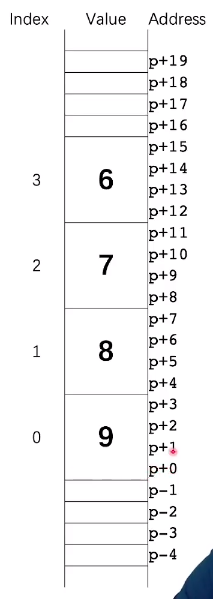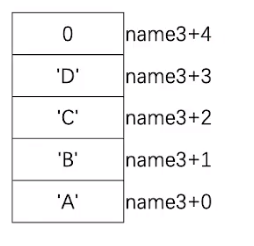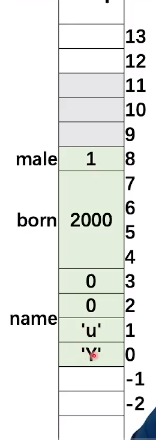Array
数组长度,下面的情况,数组长度只有在程序运行的 时候才可以确定,在编译的时候是不确定的
1
2
3
4
5
6
| int len = 1;
while (len < 10)
{
int num[len];
len ++;
}
|
注意,边长的数组是不可以初始化的
数组赋值
1
2
3
| int array1[4] = {9,8,7,6};
int array2[4];
array2 = array1;
|
在声明的时候array2的地址已经确定了,数组的等号赋值就是首地址的赋值,数组的地址是不允许更改的
下边是数组的存储方式,每一个小格子就是一个字节,9 8 7 6分别占了连续的四个字节


注意:
- 在数组的操作中,是不会有越界检查的,如果越界了没有警告没有错误
- 数组在这里不是一个对象,他就是一块连续的内存。大小是不知道的
二维数组
未知长度二维数组传参,要带上列的长度
1
2
| void init_2d_array(float mat[][], size_t rows, size_t cols) //错误
void init_2d_array(float mat[][3], size_t rows, size_t cols) //正确
|
虽然是二维数组,他还是要保存到一维内存上,下面图片对应此mat
1
| int mat[2][3] = {{11,12,13}, {14,15,16}};
|
!(Screenshot from 2022-04-01 11-22-01.png)

如果不告诉一列有多少个元素,那么他就不知道,第几个元素开始是第二行
所以传递float mat[][3]的时候需要告诉一个3,它才知道第二行从哪儿开始
字符串
array-style 字符串
数组的元素类型是char, 个数是16个。这16个元素的数组初始化为下面五个字符,后面的都被会置0.
1
| char rabbit[16] = {'P', 'e', 't', 't', 'r'};
|
下面是一个不好的字符串, 字符串需要以\0结束. ‘\0’的就是0. 该标志符表示字符串到此结束,否则打印该字符串会一直打印下去
1
2
3
| char bad_pig[4] = {'a', 'b', 'd', 'd'};
// cout << bad_pig // 会出现无限个字符的打印,相当于越界了,因为找不到\0
strlen(bad_pig) // 可能程序会崩溃掉
|
一个好的是需要加一个\0,
1
| char bad_pig[5] = {'a', 'b', 'd', 'd', '\0'};
|
上面这种定义字符串的方式很恶心,太麻烦了
常量字符串
这种定义就方便多了
1
2
| char rabbit[] = "Peter";
char name3[] = 'ABCD';
|
下面是name3的地址分布


字符串拷贝
strcpy
1
| char* strcpy(char* dest, const char* src)
|
表示拷贝src到dest中,但是如果dest的长度不够,小于src的,他依然会进行拷贝,会向后溢出字符,是很危险的
strncpy
1
| char* strncpy(char* dest, const char* src, size_t count);
|
一般,count会设置为两个字符串的最小值,就不会出现这种问题
strcat
1
| char* strcat(char* dest, const char* src)
|
把src接到dest的后面,同样也有strcpy的问题。所以也有一个strncat
strncat
strcmp
1
| int strcmp (const char *lhs, const char *rhs);
|
相同返回0, 会把lhs的第一个值减去rhs的第一个值作为返回值
string对象
std::string使用起来更方便,无须使用strcat,只需要+ 号就行
1
2
3
4
5
6
| std::string str1 = "Hello";
std::string str2 = "world";
std::string str3 = str1 + "," + str2;
cout << (str1 < str2) << endl;
cout << str1.length() << endl
|
结构体
1
2
3
4
5
6
7
8
9
10
11
12
13
14
15
16
| struct Student{
char name[4];
int born;
bool male;
};
struct Student stu;
stu.age = 2000;
strcpy(stu.name, "yu");
stu.male = true;
struct Student stu = {"yu", 2000, ture}
struct Student stus[100];
stus[50].born = 2002;
|


结构体内存对齐
结构体在内存中存在数据对齐,方便寄存器的读写
下面看一个例子
1
2
3
4
5
6
| struct Stu1{
int id;
bool male;
char label;
float weight;
}
|
1
2
3
4
5
6
| struct Stu2{
int id;
bool male;
float weight;
char label;
}
|
上面两个结构体的sizeof(Stu1)和sizeof(Stu2)分别是12个字节和16个字节
因为需要对齐0,4,8,12,让寄存器的速写更快,所以weight会在第八位进行对齐,Stu2中的label放在12位,后面三位继续补齐


在c++中,结构体和类几乎是一样的,除了public和private可以定位除外
联合体Union
定义方式和结构体一样,所有的成员享有相同的内存,长度可以不同。Union返回的sizeof大小为最大的那个成员
enum
enum的声明和上面的一样。他提供了一个可以替代const的不可变符号。
1
2
| enum color {WHITE, BLACK, RED, GREEN, BLUE, YELLOW, NUM_COLORS};
enum datatype {TYPE_INT8=1, TYPE_INT16=2, TYPE_INT32=4, TYPE_INT64=8};
|
enum, union, struct 举例
下面的例子,把enum和Union定义在一个结构体中,把不同类型的数据放入Union省下了空间
计算l1范数的时候会根据传入的数据结构类型计算范数
1
2
3
4
5
6
7
8
9
10
11
12
13
14
15
16
17
18
19
20
21
22
23
24
25
26
27
28
29
30
31
32
33
34
35
36
37
38
39
40
41
42
43
44
45
46
47
48
49
50
51
52
53
54
55
56
57
58
59
60
61
62
63
64
65
| #include <iostream>
using namespace std;
enum color {WHITE, BLACK, RED, GREEN, BLUE, YELLOW, NUM_COLORS};
enum datatype {TYPE_INT8=1, TYPE_INT16=2, TYPE_INT32=4, TYPE_INT64=8};
struct Point{
enum datatype type;
union {
std::int8_t data8[3];
std::int16_t data16[3];
std::int32_t data32[3];
std::int64_t data64[3];
};
};
size_t datawidth(struct Point pt)
{
return size_t(pt.type) * 3;
}
int64_t l1norm(struct Point pt)
{
int64_t result = 0;
switch(pt.type)
{
case (TYPE_INT8):
result = abs(pt.data8[0]) + abs(pt.data8[1]) + abs(pt.data8[2]);
break;
case (TYPE_INT16):
result = abs(pt.data16[0]) + abs(pt.data16[1]) + abs(pt.data16[2]);
break;
case (TYPE_INT32):
result = abs(pt.data32[0]) + abs(pt.data32[1]) + abs(pt.data32[2]);
break;
case (TYPE_INT64):
result = abs(pt.data64[0]) + abs(pt.data64[1]) + abs(pt.data64[2]);
break;
}
return result;
}
int main()
{
enum color pen_color = RED;
pen_color = color(3);
cout << "We have " << NUM_COLORS << " pens." << endl;
int color_index = pen_color;
color_index += 1;
cout << "color_index = " << color_index << endl;
struct Point point1 = {.type=TYPE_INT8, .data8={-2,3,4}};
struct Point point2 = {.type=TYPE_INT32, .data32={1,-2,3}};
cout << "Data width = " << datawidth(point1) << endl;
cout << "Data width = " << datawidth(point2) << endl;
cout << "L1 norm = " << l1norm(point1) << endl;
cout << "L1 norm = " << l1norm(point2) << endl;
return 0;
}
|









